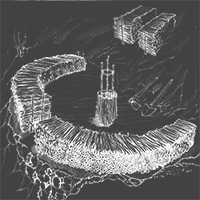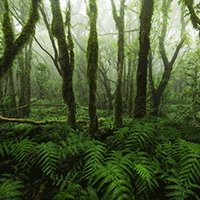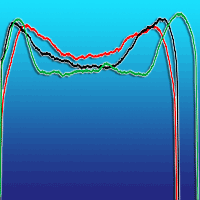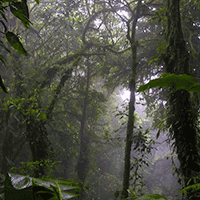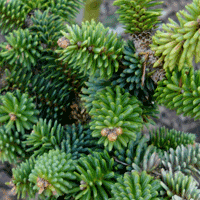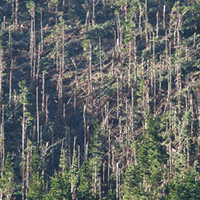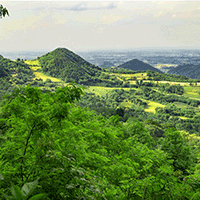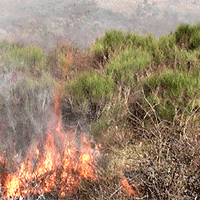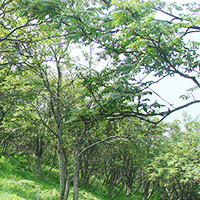Production of wood charcoal is a traditional form of forest use that lasted for millennia in the Mediterranean countries. Following their almost complete abandonment in the last century, thousands of old charcoal platforms remain in present-day forest landscapes. These sites are characterized by peculiar ecological conditions, whose effects on the recolonization by woody plants are still unknown. We examined 61 platforms in evergreen sclerophyllous woodlands and deciduous broadleaf forests with oaks and beech, spread over a wide geographic range in Tuscany (Italy). At each site, one kiln plot (on charcoal platform) and one control plot (in the adjacent stand) were established, and soil, light conditions and herb cover were measured. We examined species richness and composition of trees and shrubs in the understorey layer (<1.3 m) and in the “established regeneration” layer (> 1.3-4 m). In the latter, structural parameters such as number of stools, dbh, mean height and number of stems were compared. The density of seedlings of dominant tree species in the understorey was also measured in a subsample of sites per forest type. In the understorey, a general positive effect of kiln platforms was found on species richness at both the habitat and plot-scale level, as well as on species composition, especially in oak forests. Increased light availability, total C content and soil pH were positively related with species richness, while N content was a negative predictor. Density of seedlings was not substantially affected. Contrastingly, woody species richness in the established regeneration layer was considerably lower in the kiln plots of all three forest types. In sclerophyllous forests, all species in this layer were taller, denser and with a higher basal area compared to control plots, while regeneration was completely lacking on platforms of the two other forest types. Soil N content had a positive influence on structural parameters, while total C content resulting from charcoal accumulation had a negative influence. We conclude that charcoal platforms are a favorable microhabitat only in the first regeneration stages of woody species, as their further growth is hindered by long-term effects that should be investigated with an experimental approach.
Keywords
, , , , , ,
Citation
Carrari E, Ampoorter E, Verheyen K, Coppi A, Selvi F (2016). Former charcoal platforms in Mediterranean forest areas: a hostile microhabitat for the recolonization by woody species. iForest 10: 136-144. - doi: 10.3832/ifor1701-009
Academic Editor
Davide Ascoli
Paper history
Received: May 07, 2015
Accepted: Jun 23, 2016
First online: Oct 06, 2016
Publication Date: Feb 28, 2017
Publication Time: 3.50 months
© SISEF - The Italian Society of Silviculture and Forest Ecology 2016
Open Access
This article is distributed under the terms of the Creative Commons Attribution-Non Commercial 4.0 International (https://creativecommons.org/licenses/by-nc/4.0/), which permits unrestricted use, distribution, and reproduction in any medium, provided you give appropriate credit to the original author(s) and the source, provide a link to the Creative Commons license, and indicate if changes were made.

Breakdown by View Type
(Waiting for server response...)
Article Usage
Total Article Views: 50725
(from publication date up to now)
Breakdown by View Type
HTML Page Views: 41530
Abstract Page Views: 3074
PDF Downloads: 4853
Citation/Reference Downloads: 66
XML Downloads: 1202
Web Metrics
Days since publication: 3372
Overall contacts: 50725
Avg. contacts per week: 105.30
Article Citations
Article citations are based on data periodically collected from the Clarivate Web of Science web site
(last update: Mar 2025)
Total number of cites (since 2017): 14
Average cites per year: 1.56
Publication Metrics
by Dimensions ©
Articles citing this article
List of the papers citing this article based on CrossRef Cited-by.
(1)
Akaike H (1973)Information theory and an extension of the maximum likelihood principle. In: Proceedings of “2
nd International Symposium on Information Theory” (Petrov BN, Paki FC eds). Tsahkadsor (Armenia, USSR) 2-8 Sep 1971. Akademia Kiado, Budapest, Hungary, pp. 267-281.
Gscholar
(2)
Anderson M (2001)A new method for non-parametric multivariate analysis of variance. Austral Ecology 26: 32-46.
CrossRef |
Gscholar
(3)
Antal MJ, Gronli M (2003)The art, science, and technology of charcoal production. Industrial and Engineering Chemistry Research 42 (8): 1619-1640.
CrossRef |
Gscholar
(4)
Attwood M, Iavicoli C, Seppilli T (1981)Il Carbonaio, una tecnica tradizionale di preparazione del carbone da legna nella montagna Cortonese [The charcoal burner, a traditional technique of charcoal production on the mountains around Cortona]. La Zincografica Fiorentina, Firenze, Italy, pp. 47. [in Italian]
Gscholar
(5)
Axmanová I, Zeleny D, Li CF, Chytry M (2011)Environmental factors influencing herb layer productivity in Central European oak forests: insights from soil and biomass analyses and a phytometer experiment. Plant and Soil 342 (1-2): 183-194.
CrossRef |
Gscholar
(6)
Bates D, Maechler M, Bolker B, Walker S, Christensen RHB, Singmann H, Dai B, Eigen C, Rcpp L (2014)Package “lme4”. R Foundation for Statistical Computing, Vienna, Website.
Online |
Gscholar
(7)
Barton K (2013)MuMIn: multi-model inference. R package version 1(5), R Project for Statistical Computing, Vienna, Austria, Website.
Online |
Gscholar
(8)
Beckage B, Kloeppel BD, Yeakley JA, Taylor SF, Coleman DC (2008)Differential effects of understory and overstory gaps on tree regeneration. The Journal of the Torrey Botanical Society 135: 1-11.
CrossRef |
Gscholar
(9)
Bell MJ, Worrall F (2011)Charcoal addition to soils in NE England: a carbon sink with environmental co-benefits? Science of Total Environment 409: 1704-1714.
CrossRef |
Gscholar
(10)
Blondel J (2006)The “design” of Mediterranean landscapes: a millennial story of humans and ecological systems during the historic period. Human Ecology 34: 713-729.
CrossRef |
Gscholar
(11)
Busing RT, White PS (1997)Species diversity and small-scale disturbance in an old growth temperate forest: a consideration of gap partitioning concepts. Oikos 78: 562-568.
CrossRef |
Gscholar
(12)
Callaway RM (1995)Positive interactions among plants. The Botanical Review 61 (4): 306-349.
CrossRef |
Gscholar
(13)
Cantiani M (1955)Ricerche sperimentali sulla carbonizzazione della legna di cerro e di faggio [Experimental researches on the charcoaling process of the Turkey oak and beech timber]. Italia Forestale e Montana 10: 125-129. [in Italian]
Gscholar
(14)
Carrari E, Ampoorter E, Coppi A, Verheyen K, Selvi F (2016a)Former charcoal kiln platforms serve as microhabitats that increase the understorey diversity in Mediterranean forests. Applied Vegetation Science 19: 486-497.
CrossRef |
Gscholar
(15)
Carrari E, Ampoorter E, Coppi A, Selvi F (2016b)Diversity of secondary woody species in relation to species richness and cover of dominant trees in thermophilous deciduous forests. Scandinavian Journal of Forest Research 31: 484-494.
CrossRef |
Gscholar
(16)
Cheng CH, Lehmann J, Thies JE, Burton SD (2008)Stability of black carbon in soils across a climatic gradient. Journal of Geophysical Research 113: 2005-2012.
CrossRef |
Gscholar
(17)
Chytry M, Tichy L, Rolecek J (2003)Local and regional patterns of species richness in Central European vegetation types along the pH/calcium gradient. Folia Geobotanica 38 (4): 429-442.
CrossRef |
Gscholar
(18)
Clark CM, Cleland EE, Collins SL, Fargione JE, Gough L, Gross KL, Pennings SC, Suding KN, Grace JB (2007)Environmental and plant community determinants of species loss following nitrogen enrichment. Ecology Letters 10 (7): 596-607.
CrossRef |
Gscholar
(19)
Cremaschi M, Pizzi C, Valsecchi V (2006)Water management and land use in the terramare and a possible climatic co-factor in their abandonment: the case study of the terramara of Poviglio Santa Rosa (Northern Italy). Quaternary International 151: 87-98.
CrossRef |
Gscholar
(20)
Criscuoli I, Alberti G, Baronti S, Favilli F, Martinez C, Calzolari C, Pesceddu E, Rumpel C, Viola R, Miglietta F (2014)Carbon sequestration and fertility after centennial time scale incorporation of charcoal into soil. PloS ONE 9: e91114.
CrossRef |
Gscholar
(21)
Deforce K, Boeren I, Adriaenssens S, Bastiaens J, De Keersmaeker L, Haneca K, Tys D, Vandekerkhove K (2013)Selective woodland exploitation for charcoal production. A detailed analysis of charcoal kiln remains (ca. 1300-1900 AD) from Zoersel (northern Belgium). Journal of Archaeological Science 40 (1): 681-689.
CrossRef |
Gscholar
(22)
European Environment Agency (2007)European forest types. Categories and types for sustainable forest management reporting and policy (2nd edn). EEA Technical Report 09/2006, European Environment Agency, Copenhagen, Denmark, pp. 111.
Gscholar
(23)
European Soil Bureau Network (2005)Soil atlas of Europe. Office for Official Publications of the European Communities, European Commission, L-2995 Luxembourg, pp. 128.
Gscholar
(24)
Ewald J (2008)Plant species richness in mountain forests of the Bavarian Alps. Plant Biosystems 142 (3): 594-603.
CrossRef |
Gscholar
(25)
Gaur A, Adholeya A (2000)Effects of the particle size of soilless substrates upon AM fungus inoculum production. Mycorrhiza 10: 43-48.
CrossRef |
Gscholar
(26)
Giorgerini C (2009)Carbone e carbonaie [Charcoal and charcoal kilns]. I Quaderni del Circolo, Sassetta ed., Livorno, Italy, pp. 20. [in Italian]
Gscholar
(27)
Glaser B, Lehmann J, Zech W (2002)Ameliorating physical and chemical properties of highly weathered soils in the tropics with charcoal - a review. Biology and Fertility of Soils 35: 219-230.
CrossRef |
Gscholar
(28)
Glaser B, Haumaier L, Guggenberger G, Zech W (2001)The “Terra preta” phenomenon: a model for sustainable agriculture in the humid tropics. Naturwissenschaften 88 (1): 37-41.
CrossRef |
Gscholar
(29)
Jiménez Esquilín AE, Stromberger ME, Massman WJ, Frank JM, Shepperd WD (2007)Microbial community structure and activity in a Colorado Rocky Mountain forest soil scarred by slash pile burning. Soil Biology and Biochemistry 39: 1111-1120.
CrossRef |
Gscholar
(30)
Karhu K, Mattila T, Bergström I, Regina K (2011)Biochar addition to agricultural soil increased CH4 uptake and water holding capacity - results from a short-term pilot field study. Agriculture, Ecosystems and Environment 140: 309-313.
CrossRef |
Gscholar
(31)
Kim J-S, Sparovek G, Longo RM, De Melo WJ, Crowley D (2007)Bacterial diversity of Terra Preta and pristine forest soil from the Western Amazon. Soil Biology and Biochemistry 39: 684-690.
CrossRef |
Gscholar
(32)
Knowles OA, Robinson BH, Contangelo A, Clucas L (2011)Biochar for the mitigation of nitrate leaching from soil amended with biosolids. Science of Total Environment 409: 3206-3210.
CrossRef |
Gscholar
(33)
Korb EJ, Johnson NC, Covington WW (2004)Slash pile burning effects on soil biotic and chemical properties and plant establishment: recommendations for amelioration. Restoration Ecology 12: 52-62.
CrossRef |
Gscholar
(34)
Landi M, Piussi P (1988)Il lavoro nei boschi. Boscaioli e carbonai a Luco e Grezzano tra il 1939 e il 1950 [The work in the forest. Lamberjacks and charcoal burners at Luco and Grezzano between 1939 and 1950]. Gruppo d’Erci, Grezzano, Borgo San Lorenzo, Italy, pp. 72. [in Italian]
Gscholar
(35)
Lehmann J, Pereira da Silva J, Steiner C, Nehls T, Zech W, Glaser B (2003)Nutrient availability and leaching in an archaeological Anthrosol and a Ferralsol of the Central Amazon basin: fertilizer, manure and charcoal ramendments. Plant Soil 249: 343-357.
CrossRef |
Gscholar
(36)
Ludemann T (2003)Large-scale reconstruction of ancient forest vegetation by anthracology - a contribution from the Black Forest. Phytocoenologia 33 (4): 645-666.
CrossRef |
Gscholar
(37)
Ludemann T, Michiels HG, Nölken W (2004)Spatial patterns of past wood exploitation, natural wood supply and growth conditions: indications of natural tree species distribution by anthracological studies of charcoal-burning remains. European Journal of Forest Research 123 (4): 283-292.
CrossRef |
Gscholar
(38)
Ludemann T (2010)Past fuel wood exploitation and natural forest vegetation in the Black Forest, the Vosges and neighbouring regions in the western Central Europe. Palaeogeography Palaeoclimatology and Palaeoecology 291: 154-165.
CrossRef |
Gscholar
(39)
Ludemann T (2012)Airborn laser scanning of historical wood charcoal production sites - a new tool of kiln site anthracology at the landscape level. SAGVNTVM Extra 13: 247-252.
Gscholar
(40)
Lyon J, Sharpe WE (2003)Impacts of hay-scented fern on nutrition of northern Red Oak seedlings. Journal of Plant Nutrition 26: 487-502.
CrossRef |
Gscholar
(41)
Mikan CJ, Abrams MD (1996)Mechanisms inhibiting the forest development of historic charcoal hearths in southeastern Pennsylvania. Canadian Journal of Forest Reasearch 26: 1893-1898.
CrossRef |
Gscholar
(42)
Mikan CJ, Abrams MD (1995)Altered forest composition and soil properties of historic charcoal hearths in southeastern Pennsylvania. Canadian Journal of Forest Research 25 (5): 687-696.
CrossRef |
Gscholar
(43)
Montanari C, Prono P, Scipioni S (2000)The study of charcoal-burning sites in the Apennine Mountains of Liguria (NW Italy) as a tool for forest history. In: “Methods and Approaches in Forest History” (Agnoletti M, Anderson S eds). CABI Publishing, CAB International, Wallingford, UK, pp. 79-91.
Gscholar
(44)
Nakagawa S, Schielzeth H (2013)A general and simple method for obtaining R
2 from generalized linear mixed-effects models. Methods in Ecology and Evolution, 4: 133-142.
CrossRef |
Gscholar
(45)
Nelle O (2003)Woodland history of the last 500 years revealed by anthracological studies of charcoal kiln sites in the Bavarian Forest, Germany. Phytocoenologia 33 (4): 667-682.
CrossRef |
Gscholar
(46)
Oksanen J, Blanchet F G, Kindt R, Legendre P, Minchin PR, O’Hara RB, Simpson G L, Solymos M, Stevens M H H, Wagner H (2015)Package “vegan”. Community ecology package, version 2.3-5, R Project for Statistical Computing, Vienna, Austria, Website.
Online |
Gscholar
(47)
Pèlachs A, Nadal J, Soriano JM, Molina D, Cunill R (2009)Changes in Pyrenean woodlands as a result of the intensity of human exploitation: 2.000 years of metallurgy in Vallferrera, northeast Iberian Peninsula. Vegetation History and Archaeobotany 18: 403-416.
CrossRef |
Gscholar
(48)
Pignatti S (1982)Flora d’Italia. Edagricole, Bologna, Italy, pp. 2324. [in Italian]
Gscholar
(49)
Pinheiro J, Bates D, DebRoy S, Sarkar D (2013)“nlme”: linear and non linear mixed effect models.R Project for Statistical Computing, Vienna, Austria, Website.
Online |
Gscholar
(50)
Poulson TL, Platt TL (1989)Gap light regime influences canopy tree diversity. Ecology 70: 553-555.
CrossRef |
Gscholar
(51)
Powell A (2008)The magnetic signatures of medieval and post-medieval pyrotechnical industries, PhD thesis, University of Bradford, UK, pp. 172.
Gscholar
(52)
R Core Team (2014)R: a language and environment for statistical computing. R Foundation for Statistical Computing, Vienna, Austria.
Online |
Gscholar
(53)
Regione Toscana (2016)Settore idrogeologico regionale. Regione Toscana, Firenze, Italy, Website. [in Italian]
Online |
Gscholar
(54)
Thomas SC, Gale N (2015)Biochar and forest restoration: a review and meta-analysis of tree growth responses. New Forests 46 (5-6): 931-946.
CrossRef |
Gscholar
(55)
Valese E, Conedera M, Held AC, Ascoli D (2014)Fire, humans and landscape in the European Alpine region during the Holocene. Anthropocene 6: 63-74.
CrossRef |
Gscholar
(56)
Ventura M, Sorrenti G, Panzacchi P, Tonon G (2012)Biochar reduces nitrate leaching in an apple orchard. In: Proceedings of the “17th Nitrogen Workshop - Innovations for Sustainable Use of Nitrogen Resources” (Richards KG, Fenton O, Watson CJ eds). Springer Verlag, Wexford, Ireland, pp. 42-43.
Gscholar
(57)
Wallstedt A, Coughlan A, Munson AD, Nilsson MC, Margolis HA (2002)Mechanisms of interaction between
Kalmia angustifolia cover and
Picea mariana seedlings. Canadian Journal of Forest Research 32: 2022-2031.
CrossRef |
Gscholar
(58)
Warnock DD, Lehmann J, Kuyper TW, Rillig MC (2007)Mycorrhizal responses to biochar in soil - concepts and mechanisms. Plant and Soil 300: 9-20.
CrossRef |
Gscholar
(59)
Wittig R, Walter S, Xie Y (1999)Ehemalige Meilerplätze als Mikrostandorte des
Galio odorati-Fagetum im
Luzulo-Fagetum [Former kiln sites as microsites of
Galio odorati-Fagetum in
Luzulo-Fagetum]. Acta Biologica Benrodis 10: 57-68. [in German]
Gscholar
(60)
Young MJ, Johnson JE, Abrams MD (1996)Vegetative and edaphic characteristics on relic charcoal hearths in the Appalachian Mountains. Vegetatio 125 (1): 43-50.
CrossRef |
Gscholar
(61)
Zimmerman AR (2010)Abiotic and microbial oxidation of laboratory produced black carbon (biochar). Environmental Science and Technology 44: 1295-1301.
CrossRef |
Gscholar
(62)
Zuur A, Ieno EN, Walker N, Saveliev AA, Smith GM (2009)Mixed effects models and extensions in ecology with R. Springer, New York, USA, pp. 574.
Gscholar
